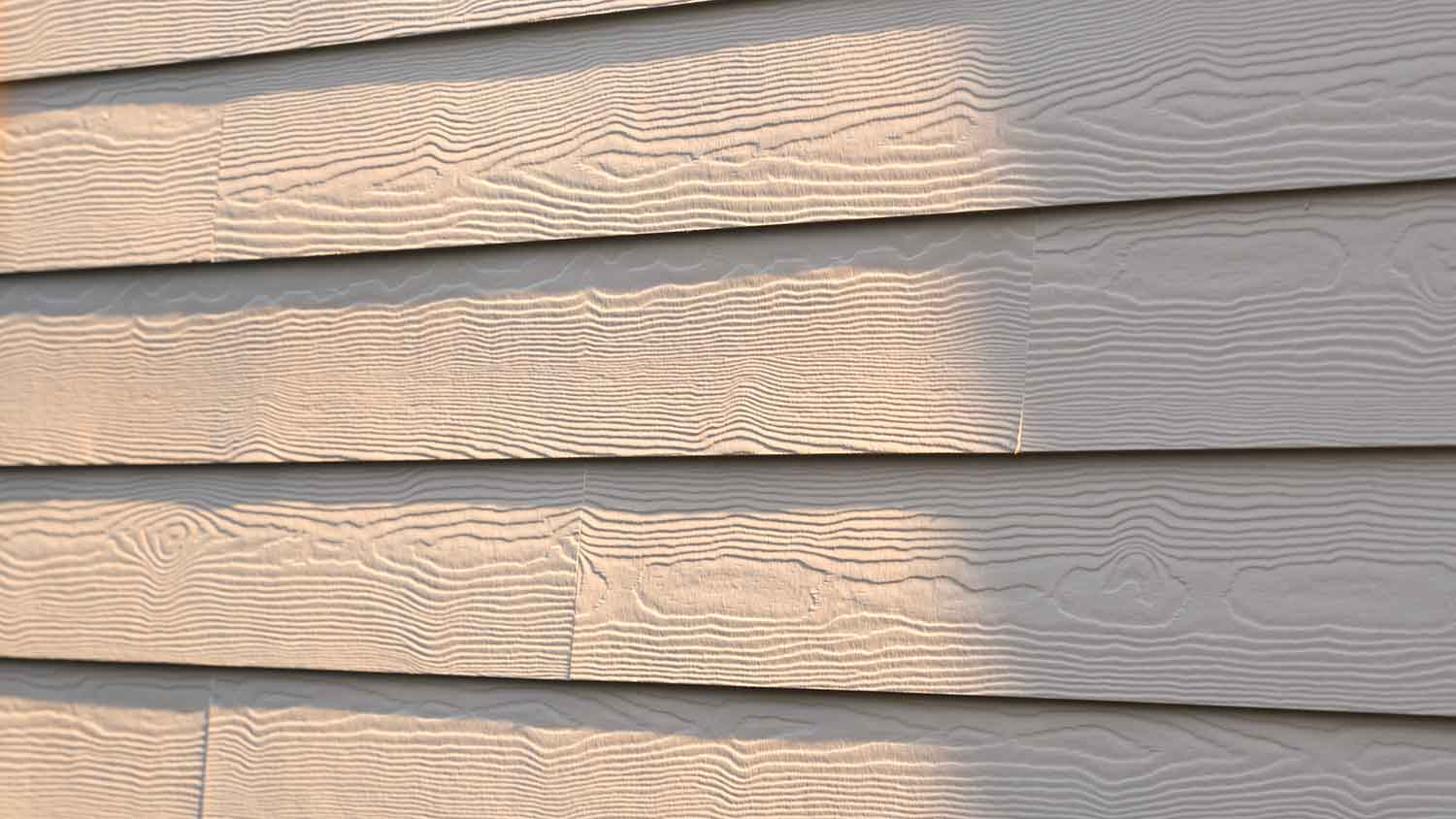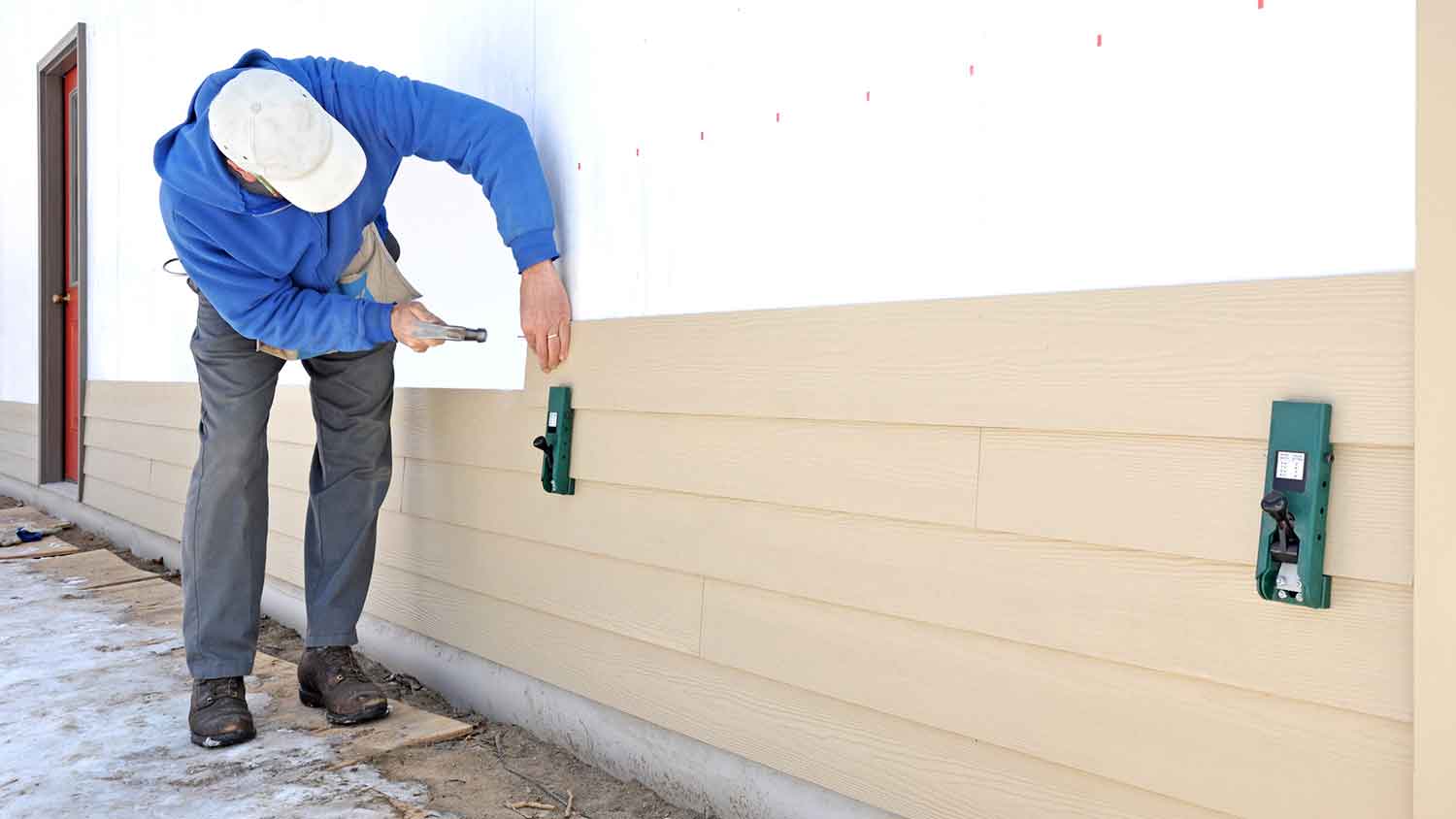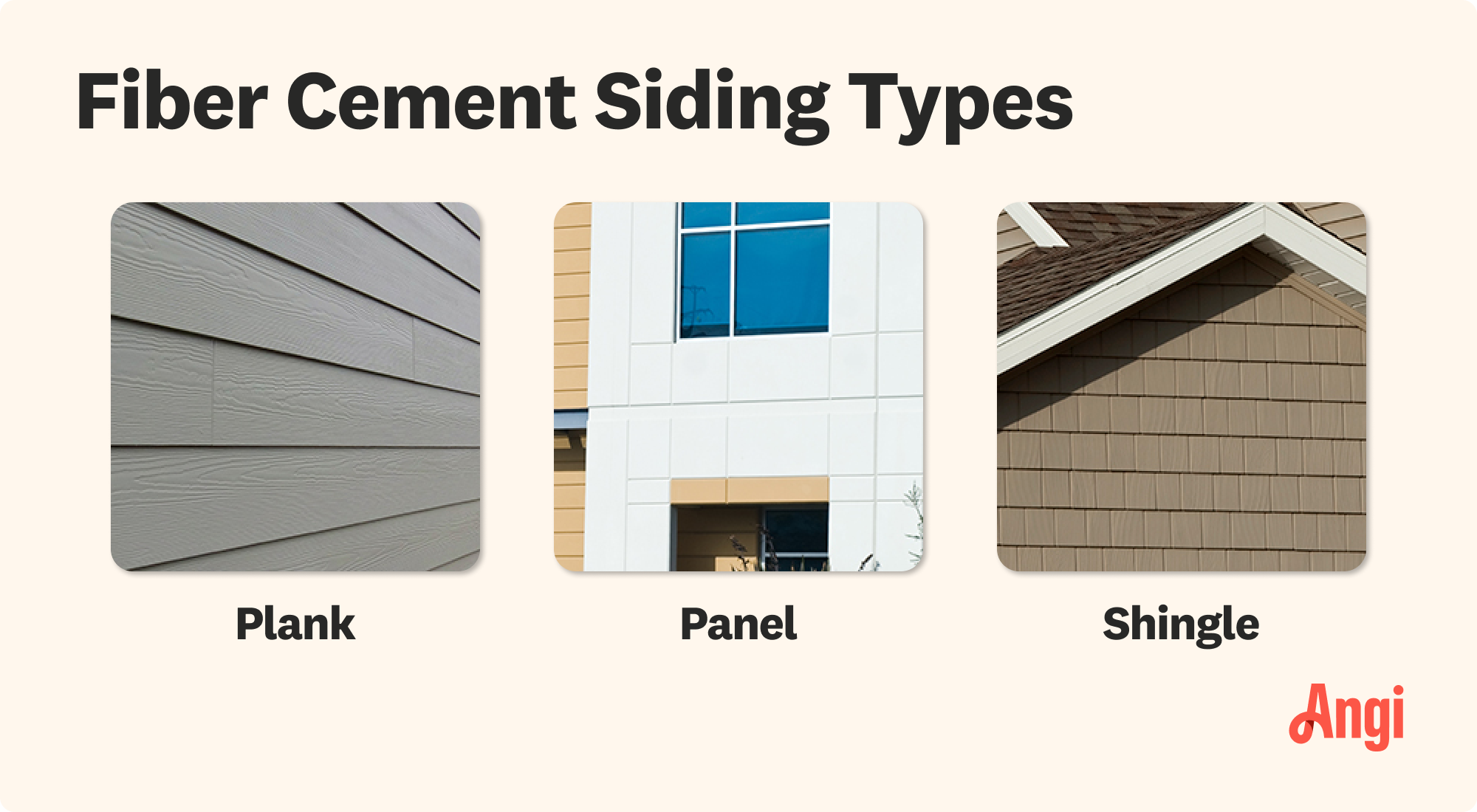
Considering a home exterior makeover with cladding? Find out the average house cladding cost to help you plan your budget.
Fiber cement siding is extremely durable, but it comes at a cost


The benefits of fiber cement siding include its longevity, durability, and resistance to pests.
Drawbacks of fiber cement material include cost, environmental impact, and maintenance.
Fiber cement siding can mimic nearly all types of siding, making it more versatile than other siding types.
The cost of fiber cement siding is $5 to $14 per square foot.
Fiber cement siding has a lot to offer your home’s exterior, mainly that it’s long-lasting and durable. Before you nail down your final decision, let’s take a look at the pros and cons of fiber cement siding and measure how it stacks up against other alternatives.
If you’ve looked up information about fiber cement siding, you’ve no doubt come across Hardie Board, which is a major manufacturer of this material by James Hardie™. Fiber cement siding was introduced in the mid-1980s as a replacement for siding containing asbestos, which was discontinued in 1989 due to safety concerns.
While Hardie Board was the first, it’s certainly not the last. Several other manufacturers now make fiber cement siding from a mixture of cellulose fibers, sand, and cement, but every manufacturer has their own composition. Consult a local siding contractor to determine whether fiber cement is the right siding material for your home.
| Pros of Fiber Cement Siding | Cons of Fiber Cement Siding |
|---|---|
| Lasts up to 50 years | Higher cost range |
| Durable against extreme weather | Not recyclable |
| Fire and heat-resistant | Heavy and difficult to install |
| Animal- and pest-resistant | Regular painting is required |
| Highly versatile |

Check out the benefits of installing fiber cement siding on your home’s exterior.
Fiber cement siding is extremely durable and holds up well against the elements. It can last up to 50 years if you keep up with maintenance, and some manufacturers' warranties can be about that long.
Durability is often the main appeal of this material. Fiber cement siding is so strong that it can withstand hurricane-strength winds and other extreme weather conditions like hail. It will not dent, warp, or rot.
Fiber cement is resistant to fire and heat, making it a smart choice if you live in an area with wildfires. It has a 0 flame spread rating, and because it’s listed as a Class 1 material, it doesn’t actively fuel a fire.
Pests like termites and beetles can’t chew or drill through fiber cement siding. It’s also safe from small animals and birds. Fiber cement siding doesn’t expand and contract either, so it doesn’t invite nesting insects.
One of the benefits of fiber cement siding is that it can mimic the look of nearly all types of siding, and most manufacturers also carry traditionally colored architectural siding to meet historical society specifications. It can be installed vertically, horizontally, or as trim and comes in various shapes, thicknesses, and textures.

Check out the problems with installing fiber cement siding on your home’s exterior.
Costing between $5 and $14 per square foot, fiber cement siding is more expensive than most other siding types. The price of fiber cement siding will depend on the manufacturer (Hardie Board is more expensive than other manufacturers), and the type—shingles are the cheapest, followed by planks and panels. Its installation may also cost more. You’ll want to reach out to a local fiber cement siding company for a more accurate estimate.
Fiber cement siding is not recyclable, which means it’s not eco-friendly. However, once installed, it’s inert and non-toxic. And because it lasts for decades, it has a low carbon footprint.
Fiber cement siding installation can be difficult. It’s heavy—50 square feet weighs about 150 pounds, and its rigidity makes it easily breakable. Cutting fiber cement releases crystalline silica, which is hazardous when inhaled.
Once fiber cement siding is installed, you’ll need to clean and paint it every decade to keep it looking fresh. While the material itself is moisture resistant, proper installation and regular maintenance are important to keep mold at bay.

Fiber cement's ability to imitate other popular siding options is one of its greatest perks. The material gives homeowners the chance to add the look of brick, stone, or wood veneer without the high price tag or maintenance issues that come with the real thing. Here are some of the most popular types of fiber cement siding.
Some of the top brands of fiber cement siding, such as James Hardie, offer panels of shingles that mimic wood and vinyl siding shingles in a full range of paintable colors.
Wood lap, or clapboard, imitates the most classic style of home siding. Long planks line up horizontally and give the appearance of classic painted wood.
Fiber cement comes in panels that imitate stucco, offering a highly durable option for modern homes and commercial buildings. While they are still complicated to install, fiber cement requires less maintenance and repairs over the years than stucco siding.
Homeowners can get that rustic charm with fiber cement by chiseling it to look like brick or stone siding. Choose from a range of brick colors and styles as well as a stone design that imitates a masonry wall.
If you’ve weighed the pros and cons of fiber cement siding and are still not convinced it’s for you, there are several other siding varieties to choose from. These are some of the most popular options.
Vinyl siding comes in many colors, textures, and styles. It’s low cost, at about $3 to $12 per square foot. It lasts up to 40 years and only needs to be cleaned with water from a garden hose.
Wood siding costs about $1 to $15 per square foot, depending on the type, and is also available in many finishes, styles, and textures. It does require paint or a stain, and it’s not impervious to moisture, pests, or weather extremes.
Aluminum siding costs about $3 to $6 per square foot, and steel costs $4 to $16 per square foot. Metal siding compared to fiber cement is low maintenance but is prone to denting. It’s available in a wide range of styles, including shingles, panels, vertical strips, and shingles.
Brick masonry and brick veneer siding both offer a classic home style with a material trusted for centuries. You'll pay anywhere between $5 and $20 per square foot for either option, though building brick masonry walls is more common during initial construction.
Similar to brick, stone siding comes either as a stone veneer or, less commonly, as a stone masonry wall. Choose between natural and manufactured stone, including fiber cement. However, you can pay up to $42 per square foot for the most sought-after stone siding materials.
EIFS siding, or Exterior Insulation and Finish Systems, has been a popular alternative to stucco since the 1970s. Its multilayered system offers durability, strong insulation, and a lighter-weight option compared to stucco.
Fiber cement siding is a great option for homeowners looking for a durable, long-lasting siding solution. Whether it’s right for your home mostly depends on your budget and your desired exterior aesthetics.
Fiber cement siding may not be the best choice if you prefer to DIY—the weight and complex installation process means this is a job best left to the pros. Hire a siding contractor who specializes in fiber cement to ensure it’s installed correctly to protect your home for decades to come. Improperly installed siding can lead to water damage, mold growth, and serious damage to your home’s exterior.
The contractor did very well for a fair price. Was professional and went the extra mile and washed even the side walk for no additional charge
I am thrilled with my new siding. My experience with Home Genius has been exceptional. Through every step of the process, Omar my project manager has explained how the process works and has answered all of my questions. The crew was friendly and professional. I highly recommend Home Genius...
Performed exterior repairs; siding and fence repairs. Came up with the most ingenious way to patch a hole in my siding - install a faux dryer vent. Absolutely brilliant and low cost. Was prompt for both the quote and the job. Great communication and sent pictures after the work was done. ...
My freezer was not working properly. It was not keeping things frozen. I have a GE side-by-side which was provided by the builder. The technician was polite, helpful, and professional. He provided me with my options which were to 1. add more freon, 2. obtain a diagnosis to determine if it...
Mottern Masonry was great to work with and we love our new patio. They were very responsive to all of our questions and were able to put in our patio in a very reasonable timeframe. We got lots of quotes and ideas and found Mottern Masonry not only very professional and timely, but also met...
All the 5 star ratings are deserved. Great company, great experience. Ben was very responsive to all my questions, and very timely on information/quotes. You name it. Cannot say enough - hire them.
Wasn't a complicated job, had to re-hang a few layers of siding that blew off in a storm. They responded quickly and showed up the same day I called. Fixed the following day. Price was reasonable. Very professional and just a great all around experience. I do recommend for anyone in...
Chris at C2 Operations was fantastic to work with. We sprung a leak several months ago but couldn't afford to have the roof replaced immediately; he sent his guys over right away to tarp it so we didn't suffer more damage. A different roofer told me he'd only tarp it if I paid him for the...
Where do I start? Let me start by saying that although my wife and I love our new home, after the experience we had during the purchase phase and due to problems we continue to have with Stanley Martin Homes, we would never purchase a new home from Stanley Martin Homes again. With that...
We are satisfied with their services. We would recommend them to others and would use them again in the future.
From average costs to expert advice, get all the answers you need to get your job done.

Considering a home exterior makeover with cladding? Find out the average house cladding cost to help you plan your budget.

Concrete log siding costs more than traditional wood but requires less maintenance. Learn about pricing and upkeep costs to see if it’s a fit for your home.

The cost of Hardie board siding depends on the size of your home and the style and color you choose. Get a more accurate estimate with our in-depth cost guide.

Not sure you want to go with the standard siding material for your home? Learn about vinyl siding pros and cons to see if there’s a better option.

Choosing the right siding can boost your curb appeal and protect your home. Our guide explores 12 siding options to help you decide.

When installing siding, you may find rotted boards underneath the old siding. Siding is your home’s first line of defense against the elements–rot causes damage that can spread, so learn about what to do when you discover rotted boards.